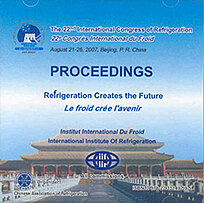
Résumé
The effect of non-condensable gases on a refrigerating circuit has been investigated for a general refrigerator. The molar fraction of non-condensable gases was varied by controlling the injection amount of dry air into the refrigerating circuit. Both energy consumption and continuous running tests for the refrigerator were conducted under the various amounts of non-condensable gases. The tested refrigerating circuit was the general household refrigerator with a suction gas heat exchanger. As the molar fraction of non-condensable gases was increased from 0 to 1.46%, the amount of energy consumption was found to increase up to 25%. The increase of the amount of non-condensable gases in refrigerating circuit was found to result in increasing the condensation temperature at the condenser and decreasing the evaporation temperature at the evaporator, which were presumably caused by the low specific heat and increased partial pressure of dry air (i.e. non-condensable gas). Also, the characteristics of the refrigerating circuit as a function of the amount of non-condensable gases were analyzed by a pressure-specific enthalpy diagram.
Documents disponibles
Format PDF
Pages : ICR07-B2-1583
Disponible
Prix public
20 €
Prix membre*
Gratuit
* meilleur tarif applicable selon le type d'adhésion (voir le détail des avantages des adhésions individuelles et collectives)
Détails
- Titre original : Effects of non-condensable gases equipped with a non-adiabatic capillary tube in domestic refrigerator.
- Identifiant de la fiche : 2008-0154
- Langues : Anglais
- Source : ICR 2007. Refrigeration Creates the Future. Proceedings of the 22nd IIR International Congress of Refrigeration.
- Date d'édition : 21/08/2007
Liens
Voir d'autres communications du même compte rendu (839)
Voir le compte rendu de la conférence
-
Auswirkungen unterschiedlicher Evakuierungsgrad...
- Auteurs : DKV, MEYER A., PHILIPP J.
- Date : 19/11/1997
- Langues : Allemand
- Source : DKV-Tagungsbericht 24. 1997, Hamburg.
Voir la fiche
-
Dynamic performance simulation of a household r...
- Auteurs : MARTÍNEZ-BALLESTER S., LEÓN MOYA B., VESSON M., et al.
- Date : 16/07/2012
- Langues : Anglais
- Source : 2012 Purdue Conferences. 14th International Refrigeration and Air-Conditioning Conference at Purdue.
- Formats : PDF
Voir la fiche
-
Stainless steel valves with enhanced fatigue an...
- Auteurs : ARDEHALI BARANI A., GEIGER K. A., HAGGENEY M., et al.
- Date : 09/07/2018
- Langues : Anglais
- Source : 2018 Purdue Conferences. 24th International Compressor Engineering Conference at Purdue.
- Formats : PDF
Voir la fiche
-
An experimental evaluation of capillary tube-su...
- Auteurs : BITTLE R. R., STEPHENSON W. R., PATE M. B.
- Date : 01/1995
- Langues : Anglais
- Source : ASHRAE Transactions.
Voir la fiche
-
Numerical modelling and experimental investigat...
- Auteurs : LIU Y. C., CAO L. H., YANG Z. H., et al.
- Date : 05/04/2008
- Langues : Anglais
- Source : Cryogenics and refrigeration. Proceedings of ICCR'2008.
Voir la fiche
